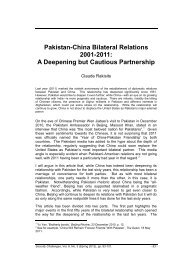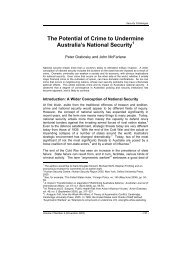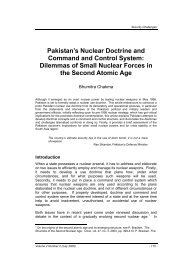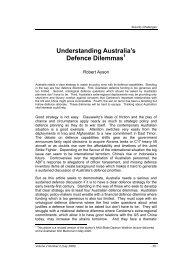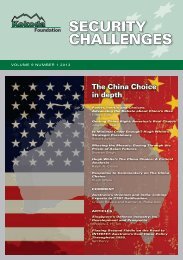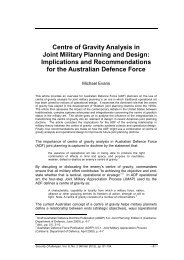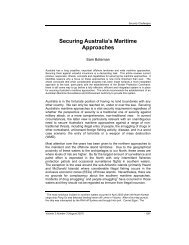The Transformation of Triad - Security Challenges
The Transformation of Triad - Security Challenges
The Transformation of Triad - Security Challenges
You also want an ePaper? Increase the reach of your titles
YUMPU automatically turns print PDFs into web optimized ePapers that Google loves.
Roderic Broadhurst and Lee King Wa<br />
triads. 163 <strong>The</strong> ICAC was zealous in enforcement despite a proto-mutiny <strong>of</strong><br />
many police in response to its special powers that led to a controversial<br />
‘partial amnesty’ being granted for minor corruption that had taken place<br />
prior to November 1977. 164 Along with powers to compel witnesses and to<br />
examine unexplained wealth that placed the burden <strong>of</strong> establishing the bona<br />
fides <strong>of</strong> the income on the defendant, the anti-corruption agency became a<br />
model for anti-corruption reforms. 165<br />
However, the breakdown <strong>of</strong> the systemic corruption in the HKP initially led to<br />
a crime wave in the mid 1970s and also peak arrests for triad-related<br />
<strong>of</strong>fences. <strong>The</strong> symbiosis between police and triads, Lethbridge argued, was<br />
strengthened in the critical 1967 Maoist riots when the triads become ‘allies’<br />
<strong>of</strong> the police and subsequently criminal enterprise and police corruption<br />
increased. 166 <strong>The</strong>reafter the increase in crime was also accounted for by<br />
Traver: ‘To the extent that the business <strong>of</strong> organised crime is business, it<br />
was in the interests <strong>of</strong> both organised crime and the police that order be<br />
maintained. Peace breeds pr<strong>of</strong>its’. 167 In addition, the existence <strong>of</strong> triads<br />
could also justify increases in resources and police powers—so amplification<br />
<strong>of</strong> the threat <strong>of</strong> the triads remained a resource. 168 In such a symbiotic stage,<br />
the legitimate political and economic sectors become dependent upon the<br />
once parasitic crime network. Organised crime and corruption was no longer<br />
only a law enforcement problem (at least at the senior level), but an acute<br />
problem <strong>of</strong> public policy. 169<br />
<strong>The</strong> colonial government’s reliance on the Societies Ordinance to suppress<br />
triads was premised upon the persistence <strong>of</strong> hierarchical command<br />
structures described by Morgan in the 1950s and an under-estimation <strong>of</strong> the<br />
extent <strong>of</strong> the corruption problem. Morgan’s informants were for the most part<br />
displaced Nationalist triads whose involvement in illicit markets established<br />
163<br />
P. N. S. Lee, ‘<strong>The</strong> Causes and Effects <strong>of</strong> Police Corruption: A Case for Political<br />
Modernization’, in Lee (ed.) Corruption and its Control in Hong Kong, pp. 105-30; T. S. Cheung<br />
and C. C. Lau, ’A Pr<strong>of</strong>ile <strong>of</strong> Syndicate Corruption in the Police Force’, in Lee (ed.) Corruption<br />
and its Control in Hong Kong, pp. 181-93; Lethbridge, Hard Graft in Hong Kong, Chapters 2-4.<br />
164<br />
Ibid., pp. 134-45.<br />
165<br />
J. R. Heilbrunn, ‘Anti-Corruption Commissions: Panacea or Real Medicine to Fight<br />
Corruption?’ (Washington, DC: <strong>The</strong> International Bank for Reconstruction and Development<br />
/<strong>The</strong> World Bank, 2004) Stock No. 37234; T. W. Lo, Corruption and Politics in Hong Kong and<br />
China.<br />
166<br />
Lethbridge, Hard Graft in Hong Kong, p. 73; such an alliance was reminiscent <strong>of</strong> the role <strong>of</strong><br />
the green gang in the suppression <strong>of</strong> the communists in 1927 in support <strong>of</strong> the nationalist<br />
government and there-after with the full support <strong>of</strong> the international settlement Shanghai<br />
Municipal Police: see Wakeman, Policing Shanghai 1927-1937, pp. 123-4.<br />
167<br />
H. Traver, ‘Crime Trends’, in H. Traver and J. Vagg (eds), Crime and Justice in Hong Kong<br />
(Hong Kong: Oxford University Press, 1991), p. 18.<br />
168<br />
Bolton, Hutton and Ip, ‘<strong>The</strong> Speech–Act Offence: Claiming and Pr<strong>of</strong>essing Membership <strong>of</strong> a<br />
<strong>Triad</strong> Society in Hong Kong’.<br />
169<br />
N. S. Lee, ‘<strong>The</strong> Causes and Effects <strong>of</strong> Police Corruption: A Case for Political Modernization’;<br />
H. C. Kuan, ‘Anti-Corruption Legislation in Hong Kong—A History’, in Lee (ed.), Corruption and<br />
its Control in Hong Kong, pp. 15-44; P. A. Lupsha, ‘Transnational Organized Crime Versus the<br />
Nation-State’, Transnational Organized Crime, vol. 2, no. 1 (1996), pp. 21-48.<br />
- 26 - <strong>Security</strong> <strong>Challenges</strong>



